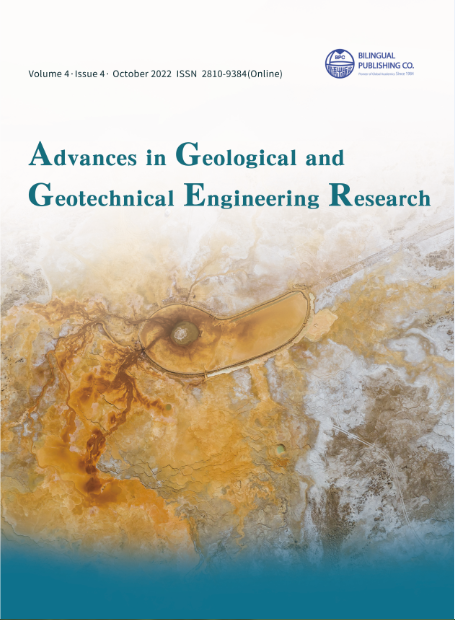-
855
-
692
-
561
-
536
-
485
Assessment of Subsurface Competency Using Geotechnical Method of a Proposed Structure F.C.T Nigeria
DOI:
https://doi.org/10.30564/agger.v4i4.5133Abstract
Structural failure has been recently happenings mostly in the commercially populated states along the coastal line in Nigeria. As a result, an open field at a chosen location in Abuja, Nigeria, was investigated. For the purpose of this study, test bores were drilled and Standard Penetration Tests (SPT) were conducted at every 1.5 m interval up to a maximum depth of 12.0 m with the bearing pressure ranging between 20 kN/m2 and 1000 kN/m2 . 3 test bores were drilled within the plot location, and samples were obtained at the test bore’s locations for laboratory analysis. Findings revealed that subsurface lithology found at the site within the explored depths of 0.0-12.0 m is mostly silty sand, laterite, sandy clay, silty clay, clayey sand, and weathered rock. The findings from the sub-soils of the different places and their bearing pressures were computed with SPT N value. Building foundations may be rigid raft foundations at a depth of 2.0 meters below the present ground level, according to bearing capacity values that range from 20 kN/m2 to 60 kN/m2 at 1.5 to 3.0 meters. The recommended building foundations take into account the sub-soil’s characteristics at the drilling places at a depth of between 1.0 and 3.0 meters. The structure might also be supported by frictional piles buried 10 meters beneath the surface.
Keywords:
Bearing, Test, Soil, Strength, DepthReferences
[1] Oyanameh, O.E., Olabode, O.O., Korode, A.I., et al., 2021. Geotechnical investigation of a proposed dam project, Iyah Gbede, Kogi State, Nigeria. International Journal of Research and Innovation in Applied Science (IJRIAS). VI(VII).
[2] Eyankware, M.O., Odoh, B.I., Akpolo, R.M., et al., 2015. Assessment of foundation of power plant at Ihie in Ukwa west local government area, Abia state southeastern Nigeria, using an integrated approach. International Journal of Geology, Agriculture and Environmental Science. 3(1), 11-19.
[3] Ibrahim, R.B., 2013. Monumental effects of building collapse in Nigerian cities: The case of Lagos Island, Nigeria. Basic Research Journal of Engineering Innovation. 1(2), 26-31.
[4] Oyedele, K.F., Oladele, S., Adedoyin, O., 2011. Application of geophysical and geotechnical methods to site characterization for construction purposes at Ikoyi, Lagos, Nigeria. Journal of Earth Sciences and Geotechnical Engineering. 1(1), 87-100.
[5] Dikedi, P.N., 2012. Geo-electric probe for groundwater in Giri, Nigeria. Global Journal of Science Frontier Research. 12(A2), 43-54.
[6] Ejembi, S., 2016. Ten Tragic Building Collapses in Nigeria [Internet]. Available from: http://www.punchng.com/10-tragic-building-collapses-in-nigeria/
[7] Clayton, C.R.I., Mattew, M.C., Simons, N.E., 1996. Site investigation, second edition. Blackwell Scientific Publishers: Oxford. pp. 318.
[8] Bell, F.G., 2011. Engineering geology, second edition. Elsevier Publishers: India. pp. 311.
[9] Adelusi, A.O., Akinlalu, A.A., Nwachukwu, A.I., 2013. Integrated geophysical investigation for post-construction studies of buildings around School of Science area, Federal University of Technology, Akure, Southwestern, Nigeria. Internet Journal of Physical Sciences. 8(15), 657-669.
[10] Amadi, A.N., Eze, C.J., Igwe, C.O., et al., 2012. Architect’s and geologist’s view on the causes of building failures in Nigeria. Modern Applied Science. 6(6).
[11] Sushma, B.V., 2009. Importance of Reliable Geotechnical Investigation for Safe and Economical Foundation Design of Civil Structures [Internet]. Available from: https://gndec.ac.in/~igs/ldh/conf/2009/articles/T01_02.pdf
[12] Edet, A.E., Okereke, C.S., 1985. Assessment of hydrogeological conditions in basement aquifers of the Precambrian Oban Massif, Southeastern Nigeria. Journal of Applied Geophysics. 36, 95-204.
[13] Malomo, S., Olorunniwo, M.A., Ogunsanwo, O., 1982. Engineering geological mapping in terrains of tropical weathering—an example from Abuja, Nigeria. Engineering Geology. (19), 133-148.
[14] Omeje, M., Husin, W., Noorddin, I., et al., 2013. Geoelectrical investigation of aquifer problems in Gosa area of Abuja, North Central, Nigeria. International Journal of Physical Sciences. 8(13), 549-559.
[15] Adeeko, T.O., Ojo, E.O., 2015. Determination of subsurface delineation using electrical resistivity sounding in Zuba and Environs of Gwagwalada Area Council, Abuja, North Central, Nigeria. Physics Journal. 1(2), 97-104.
[16] Truswell, J.F., Cope, R.N., 1963. The geology of parts of Niger and Zaria Provinces, Northern Nigeria. Geological Survey of Nigeria, Bulletin. 29, 1-104.
[17] Oyawoye, M.O., 1970. The Geology of the Nigerian Basement Complex—A Survey of Our Present Knowledge of Them [Internet].
[18] A.B.U. Consultancy Report, 1978. Geoscience investigation of the Federal Capital City Phase I (Federal Capital Site). Unpublished Report. pp. 221.
[19] McCurry, P., 1976. The geology of the precambrian to lower paleozoic rocks of Northern Nigeria—A review. Geology of Nigeria. Elizabethan Press: Lagos. pp. 15-39.
[20] Black, R., 1980. Precambrian of West Africa. Episodes. 4, 3-8.
[21] Obaje, N.G., 2009. Geology and mineral resources of Nigeria. Springer: Berlin.
[22] Grant, N.K., 1978. Structural distinction between metasedimentary cover and underlying basement in 600 m. y. old Pan African Domain of Northwestern, Nigeria, West Africa. Geological Society of America Bulletin. 89, 50-58.
[23] Abam, T.K.S., Ngah, S.A., 2013. An assessment of groundwater potentials of the Central Area District and its environs, Federal Capital City, Abuja, Nigeria. The International Journal Of Engineering And Science (IJES). 2(11), 07-12.
[24] Lekmang, I.C., Daku, S.S., Yenne, E.Y., et al., 2016. Geotechnical investigations for infrastructuraldevelopment: A case study of Daki Biyu District, Federal Capital Territory, Abuja, Central Nigeria. Journal of Geology and Mining. 8(3), 28-39.
[25] Terzaghi, K., Peck, R., 1967. Soil mechanics in engineering practice, 2nd Edition. John Wiley: New York.
Downloads
How to Cite
Issue
Article Type
License
Copyright © 2023 Osisanya O. Wasiu, Diyanuwa A. Buduwara, Korode A. Isaac, Ibitoye T. Abel, Ajibade F. Zephaniah

This is an open access article under the Creative Commons Attribution-NonCommercial 4.0 International (CC BY-NC 4.0) License.




 Osisanya O. Wasiu
Osisanya O. Wasiu





